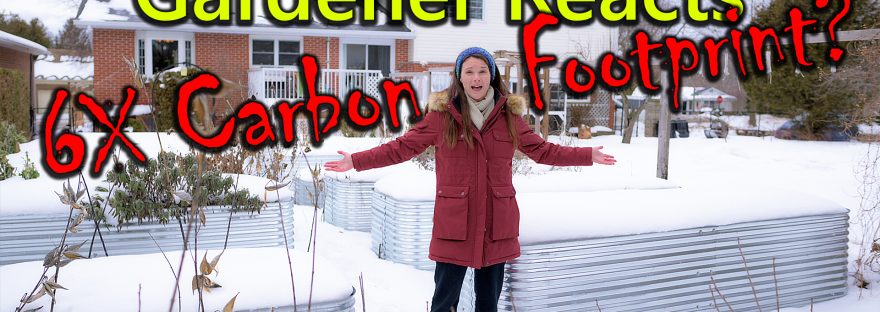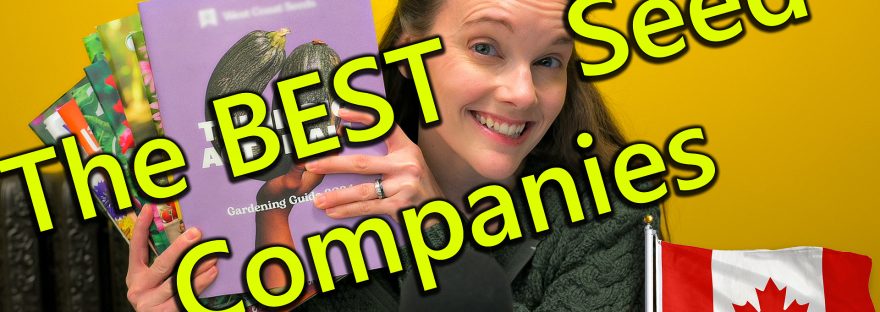My family is known to brag about our environmentally-conscious produce. Pumpkins served in pie form at Thanksgiving have been smugly referred to as ‘zero footprint’, and we’ve all thought ourselves minor climate heroes for having a second slice. Are we just greenwashing ourselves?
Recently, the largest study to date comparing urban ‘low tech’ agriculture to conventional agriculture was published(1), largely from University of Michigan researchers. The authors compared conventional (i.e. what we usually think of) farms with urban farms, home ‘kitchen’ gardens, and community gardens – and they concluded that on average, the carbon footprint of food grown in cities is inflated six-fold. Six times WORSE for the environment to grow it yourself on what would otherwise be a boring, water guzzling lawn.
What does this mean for climate-conscious home gardeners? If we care about planetary health – should we just throw in the towel and buy all of our food from conventional growers?
I give you my take on the whole thing, and why there’s plenty to keep gardening for, in this video:
Suffice it to say, the headline is dealing with average carbon footprint, and “average” has a big spectrum. Consider two home gardeners each growing a tomato – Brandy and Roma. Now, Brandy and Roma have very different biases and backgrounds, and that leads them to make different choices in their quest for yummy backyard tomatoes:
| Brandy | Roma |
|---|---|
| Builds a new garden bed in a sunny spot | Reuses the garden bed that’s been there for 10 years |
| Drives across town to buy a seedling | Starts plants at home from saved seeds |
| Buys new gadgets to protect the young plant, like a water collar and clear cloche | Waits until later in the season to transplant and doesn’t buy gadgets |
| Buys a flimsy unrecyclable trellis that will only last one season | Uses natural fibre (compostable) twine to make a string trellis |
| Buys soil, synthetic fertilizer, tomato food spikes, and a new watering can | Adds a layer of homemade compost when planting, feeds throughout the season with compost tea |
| Waters with municipal piped water | Waters with collected rain water |
So many other little details can also be different between these two growers. Maybe one uses grow lights; maybe one gets attacked by hornworms and loses half of their plants; maybe one uses recycled yogurt cups for seedlings, and the other buys new Styrofoam (ugh!!).
The point is, even without a published study it’s easy to see that some urban growing choices are better for the planet than others. The same is true with conventional growing.
What, then, is the takeaway from this study?
Essentially they found that there are three big drivers of urban agriculture’s climate impact – or, flipped around, three ways we can optimize our urban gardens.
- Reuse infrastructure. Typically, conventional growers use the same equipment and infrastructure for decades, while a home gardener may be more likely to use beds or outbuildings for only a few years. This is the biggest driver of urban carbon footprints; so if you change NOTHING else, but extend the lifespan of your gardening space a little longer (or, recycle other materials to build your garden space), you can drastically reduce your urban gardening environmental impact.
- Self check – last year the wind broke one of my arbours, and I couldn’t fix it, so it unfortunately went in the trash… and I keep adding to my garden beds every year… and I replaced existing garden beds with my metal raised beds. BUT, those beds were falling apart, and I reused the wood where I could. And I bought a second hand arbour to replace the one that broke. And I’ve made many of my garden bed borders by reusing old stone. Not all bad, but just to be sure I’d better use my garden for at least another 40 years!
- Grow things that are hard to store. Food that is:
- flown into our shops or
- requires extra packaging or
- needs a greenhouse and lots of fertilizer to grow or
- is as likely to be discarded from the store as sold
- …is all high conventional carbon cost. If we grow that food ourselves, it’s overall better for the environment.
- Use ‘urban waste’ to nurture the garden. Really, this means to amend existing soil with high quality compost and collected water. They make a point that poorly managed compost is no good – that’s actually going to increase greenhouse gas emissions. Luckily it’s pretty easy to make a good compost heap in urban settings (the key is usually good aeration!). See my How-To for more details!
- If you grow a tomato in your backyard in soil that you imported, with fertilizer that you imported, and with water that your pipes are importing – is it really ‘locally grown’ anymore?
The study is also quite optimistic that there are a lot of climate benefits to urban agriculture, despite the huge footprint (on average!). Extending their discussion:
- People who grow their own veggies tend to consume more veggies, and therefore less meat and dairy(2). One kg of beef generates 60kg of CO2e, by far the highest of any of our foods – when we eat a little less beef and other meats, we reduce the overall carbon footprint of the things that we eat.
- Spending more time in nature, as naturally tends to happen when people garden, also improves physical and mental health(3). Healthcare has a huge carbon footprint, it accounts for 5% of Canada’s annual greenhouse gas emissions, so if gardening improves physical and mental health and may lessen the burden of healthcare even a little, there are carbon savings there as well.
- Looking even more big picture, research also shows that when people do more to connect with nature, like gardening, they are more likely to address their carbon footprint in other ways(6). I know that’s true for me, the more time I spend in nature, the more I realize the importance of planetary health.
- And I also worry about my health, and my family’s health. I’m careful with the food I grow, not to contaminate the soil or spray it with noxious pesticides, because I don’t want to eat that. If all of my plants were ornamental, maybe I wouldn’t be so careful – and my pollinator friends would be more likely to get sick from my flowers.
With all of that – is it better for the environment to leave food growing to conventional farmers?
No. We should still be growing food in urban spaces, but this study highlights that there’s a lot of room for improvement. The average food produced in urban agriculture has a higher carbon cost than the average conventional farm food, but some of the sites that they studied were more carbon friendly than conventional farms. We need more urban agriculture like that, with slower infrastructure turnover, greener growing practices, and more recycled water and truly local nutrients to feed our plants.
We can always try to do better, in all spheres. That seems to be the point of the study. We shouldn’t just assume that we’re being better for the environment when we grow in our backyards, we need to continue to be environmentally mindful in our choices and to continue to research so we can learn and optimize. Canadian gardens, and other areas with shorter growing seasons, were notably absent from the data! Are there more potential gains when we’re growing our own food up north? Or more pitfalls?
One more concern raised, before I sign off; if we have a big shift to urban agriculture, and perhaps it becomes less desirable to have as many conventional farms, we have to consider what may happen to that land and if that would be a positive environmental step. With our growing population and increasing global hunger, and increasingly vulnerable food supplies, I’m not sure if that risk will come to pass, but it’s worth thinking about.
So, I’m still growing in my urban setting, and still feeling like I’m overall helping planetary health, but with lots of notes for how I can do better going forward. And for you, however your garden grows, keep growing as a gardener.
Citations:
- Comparing the carbon footprints of urban and conventional agriculture (DOI 10.1038/s44284-023-00023-3) – Hawes, J.K., Goldstein, B.P., Newell, J.P. et al. Comparing the carbon footprints of urban and conventional agriculture. Nat Cities (2024). https://doi.org/10.1038/s44284-023-00023-3
- Puigdueta, I., Aguilera, E., Cruz, J. L., Iglesias, A. & Sanz-Cobena, A. Urban agriculture may change food consumption towards low carbon diets. Global Food Security 28, 100507 (2021). ; Scarborough, P., Clark, M., Cobiac, L. et al. Vegans, vegetarians, fish-eaters and meat-eaters in the UK show discrepant environmental impacts. Nat Food 4, 565–574 (2023). https://doi.org/10.1038/s43016-023-00795-w
- White, M.P., Alcock, I., Grellier, J. et al. Spending at least 120 minutes a week in nature is associated with good health and wellbeing. Sci Rep 9, 7730 (2019). https://doi.org/10.1038/s41598-019-44097-3;
- Hunter Mary Carol R., Gillespie Brenda W., Chen Sophie Yu-Pu. Urban Nature Experiences Reduce Stress in the Context of Daily Life Based on Salivary Biomarkers. Front. Psychol., 04 April 2019 – Sec. Environmental Psychology
Volume 10 – 2019 | https://doi.org/10.3389/fpsyg.2019.00722 ; - Caoimhe Twohig-Bennett, Andy Jones, The health benefits of the great outdoors: A systematic review and meta-analysis of greenspace exposure and health outcomes, Environmental Research, Volume 166, 2018, Pages 628-637, ISSN 0013-9351, https://doi.org/10.1016/j.envres.2018.06.030.
- Caroline M.L. Mackay, Michael T. Schmitt, Do people who feel connected to nature do more to protect it? A meta-analysis, Journal of Environmental Psychology, Volume 65, 2019, 101323, ISSN 0272-4944, https://doi.org/10.1016/j.jenvp.2019.101323.


